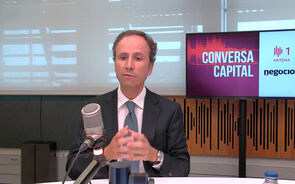May's flash crash
2 mensagens
|Página 1 de 1
Re: May's flash crash
Luis19 Escreveu:Single trade helped spark May's flash crash
Fonte: http://www.reuters.com/article/idUSTRE6 ... geNumber=1
A CME parece não concordar com a conclusão do relatório.
http://cmegroup.mediaroom.com/index.php ... te=article
"The 75,000 contracts represented 1.3% of the total E-Mini volume of 5.7 million contracts on May 6 and less than 9% of the volume during the time period in which the orders were executed. The prevailing market sentiment was evident well before these orders were placed, and the orders, as well as the manner in which they were entered, were both legitimate and consistent with market practices. These hedging orders were entered in relatively small quantities and in a manner designed to dynamically adapt to market liquidity by participating in a target percentage of 9% of the volume executed in the market. As a result of the significant volumes traded in the market, the hedge was completed in approximately twenty minutes, with more than half of the participant's volume executed as the market rallied – not as the market declined. Additionally, the aggregate size of this participant's orders was not known to other market participants.
Additionally, the most precipitous period of market decline in the E-Mini S&P 500 futures on May 6 occurred during the 3½ minute period immediately preceding the market bottom that was established at 13:45:28. During that period, the participant hedging its portfolio represented less than 5% of the total volume of sales in the market."
"In a losing game such as trading, we shall start against the majority and assume we are wrong until proven correct!" - Phantom of the Pits
May's flash crash
Single trade helped spark May's flash crash
(Reuters) - A computer-driven sale worth $4.1 billion by a single trader helped trigger the May flash crash, setting off liquidity shocks that ricocheted between U.S. futures and stock markets, regulators concluded in a report.
The report by the U.S. Securities and Exchange Commission and the Commodity Futures Trading Commission did not name the trader. Reuters, citing internal documents prepared by exchange operator CME Group Inc, in May identified the trader as money manager Waddell & Reed Financial Inc.
The long-awaited report focused on the relationship between two hugely popular securities -- E-Mini Standard & Poor's 500 futures and S&P 500 "SPDR" exchange-traded funds -- and detailed how high-frequency algorithmic trading can sap liquidity and rock the marketplace.
"The interaction between automated execution programs and algorithmic trading strategies can quickly erode liquidity and result in disorderly markets," the report said.
The "flash crash" sent the Dow Jones industrial average plunging some 700 points in minutes on May 6, exposing flaws in the electronic marketplace dominated by high-speed trading. The Dow was down nearly 1,000 points at its lowest point on that day.
Although the report did not make any recommendations, it lays the foundation for a special commission to propose new rules to avoid a repetition. At least one lawmaker threatened congressional action if regulators did not address the disparity in the markets.
Trading was turbulent that afternoon because of concerns over the European debt crisis. Against that backdrop, a "large fundamental trader" initiated a sell program to sell 75,000 E-Mini contracts as a hedge to an existing equity position, according to the 104-page report.
Citing documents from CME Group, Reuters reported on May 14 that Waddell sold a large order of E-Minis during the market plunge, identifying the firm to which the chairman of the Commodity Futures Trading Commission, Gary Gensler, had alluded in congressional testimony.
The CFTC had resisted naming Waddell in Friday's report because of laws that allow it to withhold such information from the public, sources have said.
SEC and CFTC officials declined to comment on whether they were investigating Waddell for any wrongdoing. Waddell, of Overland Park, Kansas, declined to comment on the report.
THE 'HOT-POTATO' EFFECT
Waddell's selling algorithm had "no regard to price or time," the report said. That, coupled with the "aggressive" reaction by high-frequency traders hedging their positions, led to two separate "liquidity crises" -- one in the E-minis, the other among individual stocks.
Waddell's algo "responded to the increased volume by increasing the rate at which it was feeding the orders into the market, even though orders that it already had sent to the market were arguably not yet fully absorbed by fundamental buyers or cross-market arbitrageurs," the report said.
These arbitrageurs transferred the selling pressure to the stock market, sparking a "hot-potato" effect among high-frequency traders that rapidly passed the same positions back and forth.
The stock market, the report continued, began plunging as trading pauses kicked in at individual firms, as high-frequency traders became net sellers, and as market makers began routing "most, if not all," retail orders to the public markets -- a flood of unusual selling pressure that sucked up more dwindling liquidity.
Shares of Waddell edged higher on Friday. They fell sharply on the day of the initial Reuters report.
RECOMMENDATIONS ON THE HORIZON
The unprecedented flash crash called into question many of the regulatory and technological changes over the last decade, which ushered in an era of lightning-quick trading on dozens of mostly electronic exchanges and alternative venues.
Data to the beginning of this month show that funds have exited mutual funds in every week since early May. Meanwhile, the 20-day moving average of the S&P 500's daily volume shows a slow decline since late May, according to Reuters data.
"I do not expect today's report to restore the confidence that was lost as a result of the flash crash," said David Joy, Minneapolis-based chief market strategist at Columbia Management, a large money manager.
"Most individual investors do not fully understand how high-frequency trading works, only that it can create volatility and seems to put them at a disadvantage. Only time, and higher stock prices, will restore that lost confidence."
The SEC, under enormous political and public pressure to act, in the last few months adopted new trading curbs known as circuit breakers and proposed establishing a consolidated audit trail of all stock trading.
Lawmakers seized on the latest report as a reason for the SEC to do more to fix the fragmented markets.
"The SEC should seriously consider ways to slow things down when markets get volatile," said Democratic Senator Charles Schumer.
Democratic Representative Paul Kanjorski said regulators must act quickly to revise market rules.
If necessary, Congress must "put in place new rules of the road to ensure the fair, orderly and efficient functioning of the U.S. capital markets," Kanjorski said.
The flash crash report comes just as the SEC and the CFTC have begun drafting nearly 200 rules required by the landmark U.S. Wall Street reform legislation, which includes a revamp of the opaque over-the-counter derivatives market.
(Reporting by Jonathan Spicer and Rachelle Younglai. Additional reporting by Herbert Lash in New York; Editing by Richard Chang and Robert MacMillan)
Fonte: http://www.reuters.com/article/idUSTRE6 ... geNumber=1
O autor não assume quaisquer responsabilidades sobre as decisões tomadas por outros relativamente aos factos por ele mencionados.
- Mensagens: 407
- Registado: 4/12/2007 16:30
- Localização: 14
2 mensagens
|Página 1 de 1

